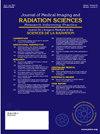利用拟人模型评估死后心脏 CT 的图像质量
IF 1.3
Q3 RADIOLOGY, NUCLEAR MEDICINE & MEDICAL IMAGING
Journal of Medical Imaging and Radiation Sciences
Pub Date : 2025-03-07
DOI:10.1016/j.jmir.2025.101876
引用次数: 0
摘要
背景:非化学性心脏病是世界范围内死亡的主要原因。冠状动脉计算机断层血管造影(CCTA)已被认为是一种诊断动脉粥样硬化斑块的方法。用于测试CT扫描仪上新技术发展的诊断准确性的一种方法是死后成像。本研究旨在比较在拟人化幻影中扫描的死后心脏的CCTA图像质量与直接在扫描床上扫描的图像质量,并评估哪种图像与活体扫描(活体患者)最具可比性。方法采用两种方法对10颗死后心脏进行扫描,并采用10颗体内CCTA进行比较。对左、右心室进行感兴趣区(ROI)测量,冠状动脉分析测量斑块负担和组成。为了检验每种扫描方法之间的差异,我们比较了这些测量的平均值和标准差。还通过图像和点阵图直观地检查了图像质量的差异。结果Wilcoxon sign Rank检验显示,两种方法的ROI测量值存在显著差异。曼-惠特尼- u测试显示,体内测量和两种死后扫描方法之间存在显著差异。Wilcoxon sign -rank检验显示5个斑块测量值中的4个有显著差异。视觉上,使用幻像可以看到更嘈杂的图像,尽管它更接近活体成像,并且有更清晰的斑块可视化。结论直接在扫描床上对心脏进行的扫描与在幻体内进行的扫描在图像质量上存在显著差异,而在幻体内进行的扫描与在体内的扫描更具可比性。这突出了在对死后器官成像时使用适当的扫描技术的重要性。本文章由计算机程序翻译,如有差异,请以英文原文为准。
Evaluating image quality on post-mortem cardiac CT using an anthropomorphic phantom
Background
Ischemic heart disease is a major cause of mortality worldwide. Coronary computed tomography angiography (CCTA) has been recognised as a procedure for diagnosing atherosclerotic plaques. One method used to test the diagnostic accuracy of new technical developments on the CT scanner is post-mortem imaging. This study aimed to compare image quality of CCTA on post-mortem hearts scanned inside an anthropomorphic phantom versus scanning directly on the scanner bed, and evaluate which image was most comparable to scanning in-vivo (living patients).
Methods
Ten post-mortem hearts were scanned using the two methods and ten CCTA in-vivo were included for comparison. Region of interest (ROI) measurements in both the right and left ventricles of the hearts were made and coronary vessel analysis measured plaque burden and composition. To examine the difference between each scanning method, we compared the mean and standard deviation of these measurements. The difference in image quality was also examined visually through images and a dot plot.
Results
A Wilcoxon Signed Rank test showed that ROI measurements from the two methods were significantly different. Mann-Whitney-U tests showed a significant difference between the in-vivo measurements and the two post-mortem scanning methods. Wilcoxon signed-rank tests indicated a significant difference for 4 out of 5 plaque measurements. Visually, a noisier image was seen using the phantom, though it was closer to in-vivo imaging and had a clearer plaque visualisation.
Conclusion
A significant difference in image quality between scans taken with the heart directly on the scanner bed compared to inside the phantom, with those inside the phantom being more comparable to in-vivo scans. This highlights the importance of using an appropriate scanning technique when imaging post-mortem organs.
求助全文
通过发布文献求助,成功后即可免费获取论文全文。
去求助
来源期刊

Journal of Medical Imaging and Radiation Sciences
RADIOLOGY, NUCLEAR MEDICINE & MEDICAL IMAGING-
CiteScore
2.30
自引率
11.10%
发文量
231
审稿时长
53 days
期刊介绍:
Journal of Medical Imaging and Radiation Sciences is the official peer-reviewed journal of the Canadian Association of Medical Radiation Technologists. This journal is published four times a year and is circulated to approximately 11,000 medical radiation technologists, libraries and radiology departments throughout Canada, the United States and overseas. The Journal publishes articles on recent research, new technology and techniques, professional practices, technologists viewpoints as well as relevant book reviews.
 求助内容:
求助内容: 应助结果提醒方式:
应助结果提醒方式:


